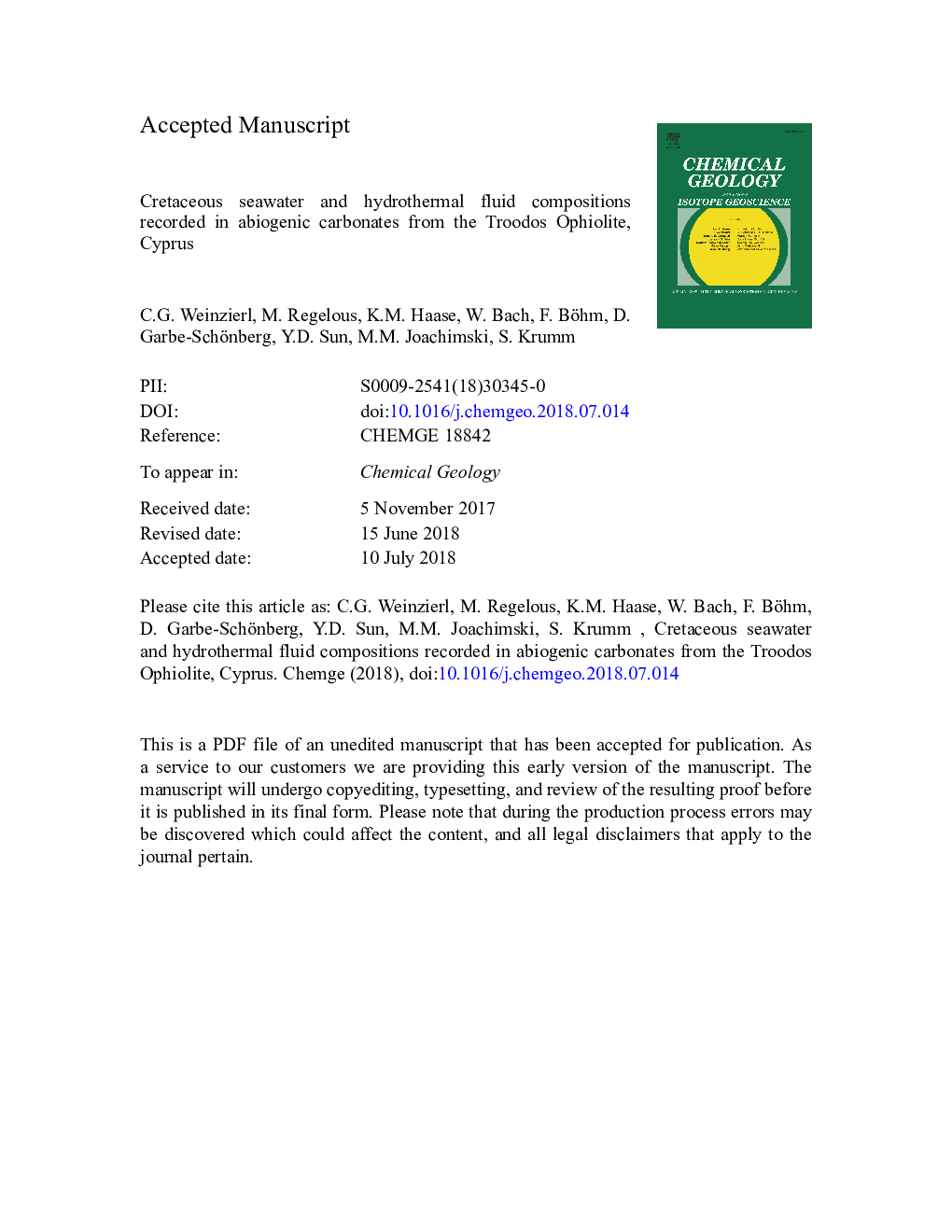| کد مقاله | کد نشریه | سال انتشار | مقاله انگلیسی | نسخه تمام متن |
|---|---|---|---|---|
| 8910116 | 1637480 | 2018 | 57 صفحه PDF | دانلود رایگان |
عنوان انگلیسی مقاله ISI
Cretaceous seawater and hydrothermal fluid compositions recorded in abiogenic carbonates from the Troodos Ophiolite, Cyprus
دانلود مقاله + سفارش ترجمه
دانلود مقاله ISI انگلیسی
رایگان برای ایرانیان
کلمات کلیدی
87Sr/86Sr - 87Sr / 86SrMg/Ca - Mg / CaSr/Ca - Sr / CaSeawater - آب دریاOphiolite - افیولیتOxygen isotopes - ایزوتوپ های اکسیژنTroodos - ترودوسseawater composition - ترکیب آب دریاAlteration - تغییرFluid evolution - تکامل سیالCretaceous - دوره کرتاسهHydrothermal fluid - مایع هیدروترمالThermodynamic model - مدل ترمودینامیکیCO2 - کربن دیاکسیدCarbonates - کربنات
موضوعات مرتبط
مهندسی و علوم پایه
علوم زمین و سیارات
ژئوشیمی و پترولوژی
پیش نمایش صفحه اول مقاله

چکیده انگلیسی
We evaluate the potential of ophiolites as archives of paleoseawater and hydrothermal fluid compositions by analysing the chemical and isotopic composition of abiogenic carbonates, precipitated from fluids within the oceanic crust of the 91â¯Ma Troodos Ophiolite, Cyprus. Calculated variations in fluid Mg/Ca, Sr/Ca and 87Sr/86Sr with temperature within the upper sections of the ophiolite are similar to those from drilled oceanic crust, and yield literature values for late Cretaceous seawater Mg/Ca, Sr/Ca and 87Sr/86Sr. This indicates that carbonates from ophiolites could be used to estimate the composition of ancient seawater at times before the age of the oldest preserved in-situ oceanic crust. Whereas most carbonates recovered from in-situ oceanic crust were precipitated at temperatures <60â¯Â°C, abiogenic carbonates from the Troodos Ophiolite formed over a temperature range of 7â¯Â°C to 218â¯Â°C. These provide unique insights into the chemical and mineralogical processes that transform seawater into a high temperature hydrothermal fluid within the oceanic crust. We use 'hydrothermal variation diagrams' of Mg/Ca, Sr/Ca, 87Sr/86Sr and δ44/40Ca versus calculated temperature (δ18O) to trace this fluid evolution within the Troodos oceanic crust. We find that successive fluid-crust-interaction, the precipitation of Mg- and Ca-bearing minerals and the early formation of anhydrite (>44â¯Â°C) gradually transform Cretaceous seawater into a Troodos hydrothermal fluid. Comparison of the Troodos data with a global dataset of abiogenic carbonates from in-situ oceanic crust shows that the chemical pathways of low-temperature fluid evolution are similar for all Cretaceous sites. These different sites represent varied geotectonic settings (mid-ocean ridge vs. suprasubduction zone), with different basement composition (basalt, basaltic andesite/boninite) and situated in different ocean basins (Atlantic, Pacific, Mediterranean [Tethys]). The similarity in the carbonate record indicates that these differences do not significantly influence seafloor weathering and hydrothermal alteration at low temperatures. However, abiogenic carbonates from younger oceanic crust differ from the Cretaceous trends and follow different fluid evolution pathways. This indicates, that temporal variations in the composition of seawater may control the nature and the extent of seafloor weathering and hydrothermal alteration at low temperatures. A thermodynamic model of fluid-crust interaction, in which modern and Cretaceous seawater are heated to 200â¯Â°C while an average Troodos basaltic andesite is successively added under otherwise identical conditions predicts that fluid evolution and alteration of the oceanic crust were different in the Cretaceous than they are today, and that initial seawater chemistry affects the nature and the extent of seafloor alteration up to moderate fluid temperatures. For example, twice the amount of carbonate formed during alteration of the oceanic crust in the Cretaceous compared to modern times, indicating that the flux of CO2 from the hydrosphere-atmosphere system into the oceanic crust was greater in the Cretaceous than it is nowadays, and that it probably varied throughout geologic time.
ناشر
Database: Elsevier - ScienceDirect (ساینس دایرکت)
Journal: Chemical Geology - Volume 494, 5 September 2018, Pages 43-55
Journal: Chemical Geology - Volume 494, 5 September 2018, Pages 43-55
نویسندگان
C.G. Weinzierl, M. Regelous, K.M. Haase, W. Bach, F. Böhm, D. Garbe-Schönberg, Y.D. Sun, M.M. Joachimski, S. Krumm,